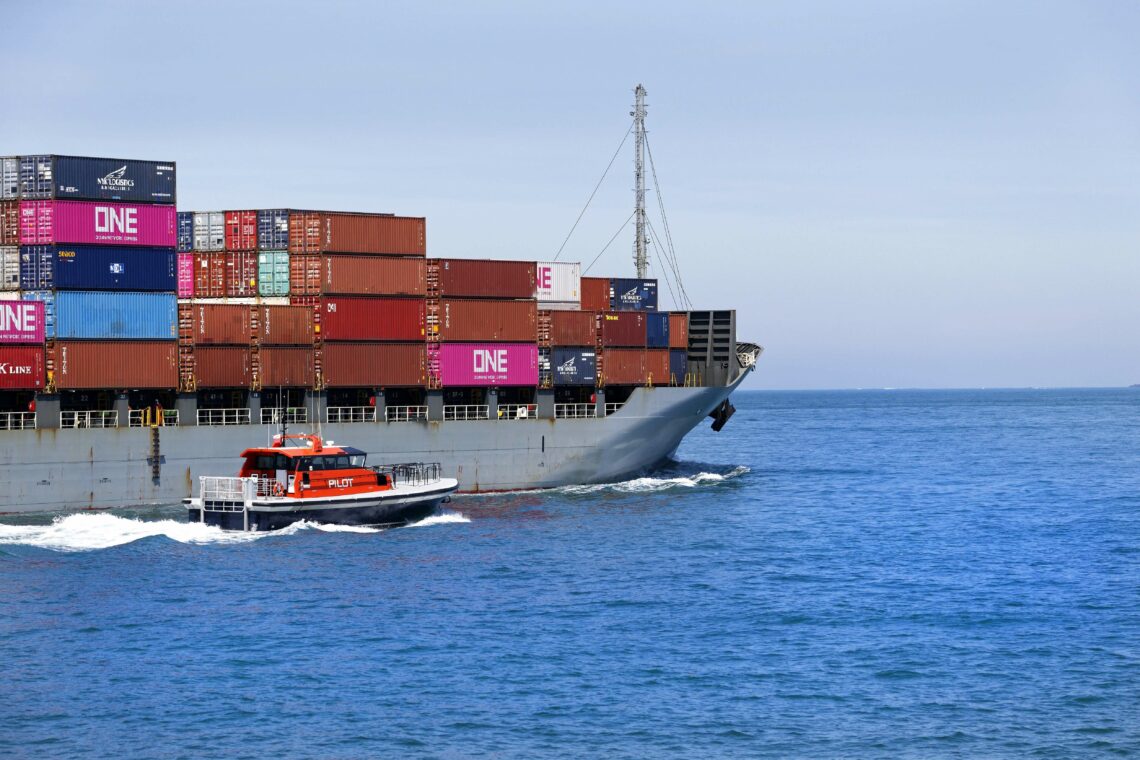Blockchain in shipping, more than a buzzword
Blockchain could lighten the administrative load of the maritime industry. However, companies are hesitant to adopt the technology due to the legal unclarity. The lack of comprehensive regulations is perceived as a security liability, but there are also fears of overregulation during the next term of the EU commission.

In a nutshell
- Thanks to blockchain, shipping companies could deflect cyberattacks and boost their efficiency
- The threat of overregulation prevents many companies from investing in the technology
- EU merger, antitrust and competition regulations could stifle innovation in the field
Blockchain technology has taken the world by storm. Its revolutionary virtual data structure is both safe and transparent, offering grand and far-reaching possibilities. The World Economic Forum estimates in its 2018 white paper “A New Age for Trade and Supply Chain Finance” that new digital technologies such as blockchain can facilitate around $1.1 trillion of new trade globally. However, the gap between the theoretical potential and the practical use of the technology has been immense, and is uncharted waters for many companies. For the transport sector in general and the maritime sector more specifically, blockchain offers great potential to facilitate seamless transit and increase global trade, but challenges lie ahead.
What is blockchain?
Blockchain technology is a digital infrastructure that allows a group of participants to manage information securely and effectively, in a variety of ways that fits the specific needs of the group.
Blockchain is traditionally associated with virtual currencies like Bitcoin, which facilitate instant monetary transactions without the involvement of third parties to identify or track transactions. Over the last few years, it has become one of the most important digital technologies across different sectors and industrial landscapes, beyond the exchange of cryptocurrencies.
At its core, blockchain is a decentralized and distributed method of digital storage where all the users of the network can access the information without relying on a central point of control for security and quality. Through the use of distributed ledgers, information is stored, shared and synchronized across multiple computers rapidly.
The benefit of such a structure is immutability, since it would be extremely difficult for hostile agents, like hackers, to tamper with the data. Since blockchains are decentralized and distributed, a single computer does not have the computing power required to modify the whole chain. In other words, all participants have an overview of the process, making it almost impossible for anyone to secretly change or forge documents.
Hope or hype?
In 2017, the shipping container company A.P. Moller-Maersk reported nearly $300 million in lost revenue after a cyberattack on its centralized system. The attack could have been avoided if the company had used a blockchain-based system, and the incident increased the industry’s interest in the emerging technology.
Apart from deflecting cyberattacks, shipping companies could also boost their administrative efficiency. According to the International Chamber of Shipping, approximately 90 percent of the world’s goods are transported by sea. However, as a sector, shipping depends on considerable paperwork and bureaucratic processes, sometimes requiring several hundred communications and numerous sign-offs of documents for a single shipment – living up to the saying that every container filled with goods is accompanied by a container filled with paper. Such procedures are costly, amounting on average to 10-20 percent of the actual transportation costs. Blockchain has the potential to change this. Digitally transferring documents, for example bills of lading, would lighten the bureaucratic load and minimize risks of tampering or loss.
Digitally transferring documents would lighten the bureaucratic load and minimize risks of tampering or loss.
Furthermore, blockchain can prove an excellent tool for handling disputes, which according to some sources costs the transport industry billions of dollars. With fast access to immutable proof in the chain of custody, blockchain could make dispute resolution a speedy matter. Additionally, smart contracts could allow payment to be coded through blockchain and executed automatically when predetermined conditions (such as port delivery) are met, again saving time and money.
The many blockchain opportunities in shipping are being anxiously explored by industry partnerships – such as the one between A.P. Moller-Maersk and tech provider IBM – through blockchain platforms like TradeLens. However, in practice the industry has not found it easy to navigate through the different risks and gray zones due to the volatile nature of blockchain.
Blockchain is frequently used for facilitating quick transactions, but the benefit of speed might not apply to maritime transport; if the number of participants in the platform increases, it could lead to a slower verification process. Moreover, while security is a cornerstone of the digital ledger technology (DLT), a system can also become diluted. In a big consortium lacking overview, someone might end up controlling more than 51 percent of the computing power, allowing them to tamper with information and leaving companies exposed to digital havoc.

Fragmented regulations
The biggest risk lurking around the corner is not technological. What is more likely to slow down investments, funding and use of DLTs is legislation. One of the main questions from the industry has been whether governments will overregulate disruptive technologies such as blockchain. This uncertainty keeps many companies from investing and exploring, hindering valuable development and deployment opportunities. Theoretically, the gray zones surrounding blockchain technology could be made clearer through soft law measures such as guidelines, interpretations, and memoranda. Nevertheless, it is unclear if the latter would be sufficient in practice.
Fear of overregulation has been echoed by the former Austrian Minister of Digital and Economic Affairs, Margarete Schrambock, during a blockchain summit in Vienna in April 2019. There, she stated that there is no need for blockchain regulation, and that Europe’s strong tendency to overregulate might prevent European blockchain companies from becoming global leaders in the field. Similar concerns have been voiced by Chinese e-commerce giant Alibaba founder Jack Ma, who believes that contrary to China and the United States, the European regulatory environment has prevented Europe from producing tech giants.
Europe’s tendency to overregulate might prevent European blockchain companies from becoming global leaders in the field.
However, despite fears of overregulation, recent market trends in shipping show that there is a need for some regulation. In September 2019, the Hong Kong-based maritime blockchain platform 300cubits shut down due to insufficient business caused by the lack of a regulative framework surrounding DLTs and digital currencies, in particular a framework ensuring interoperability between technologies. This clearly illustrates that the sector is also concerned with under-regulation.
Countries have varied greatly in their attempts to regulate blockchain. China used to be at the forefront of DLTs but eventually restricted their potential by treating DLTs and cryptocurrencies with greater suspicion. As of October 2019, China has rekindled its ambition to become a global blockchain leader, and President Xi Jinping has declared the importance of blockchain technology and the need to speed up its development.
Following China’s former approach to DLT and cryptocurrency, Germany is set to harshly regulate the technology as of January 1, 2020. The new legislation will have far-reaching economic consequences for start-ups and companies, according to blockchain experts Benjamin Schaub and Philipp Sandner.
These legal issues have prompted the industry to find a balance between too much regulation, which would stifle development, and too little, which would prolong legal uncertainty. Liechtenstein is currently attempting to strike the right chord with its Blockchain Act, which will enter into force on January 1, 2020. The legislation aims to facilitate innovation through a progressive and holistic approach, while providing legal certainty for the market.
In parallel, Japan was pushing for international consensus and a multilateral response to cryptocurrencies and DLTs during the G20 summit in the summer of 2019. The hope was that some level of standardization and interoperability across countries would be established, and lead the industry to glance toward the European Union as a potential regulator.
Scenarios
The new EU Commission, which took office on December 1, 2019, will undoubtedly prioritize the digital agenda. Margrethe Vestager’s role as executive vice president, according to EC President Ursula von der Leyen’s mission letter, is to make Europe fit for the digital age. Preliminary documents show the commission intends to create new rules governing digital platforms, the EU Digital Services Act, as well as promote digital taxation at the supranational level. The act, which will likely extend beyond the EU’s jurisdiction, could become a significant barrier for blockchain companies or companies that use the technology in their day-to-day business.
Ms. Vestager’s prior work on competition has created a clear precedent; the commission has taken an increasingly tougher stance against not only tech giants but also large partnerships, subjecting them to rigorous EU scrutiny.
Thierry Breton, new commissioner-designate for the internal market portfolio, also advocates protective policies on everything digital. It is likely that the EU will face unintended consequences for maintaining its competition policy in the blockchain space, paradoxically imposing a centralized structure on a decentralized one. Despite the commission’s determination to boost the EU’s capacity to compete with the U.S. and China on digital platforms and innovation in the coming years, when it comes to blockchain it will struggle to find the right balance between ambition and its suspicion of tech firms and partnerships.
While competition law might not seem like a threat to blockchain at first glance, in practice partnerships such as the TradeLens initiative could eventually be targeted with antitrust fines, especially if they become leading blockchain consortiums in shipping.
With DLTs, the biggest competition law question for legislators will most likely be information exchange. Taking into account how the EU has led its competition policy, it will probably want to ensure that companies using new technologies cannot collude by sharing information about prices, clients, supply and demand, costs, future conduct and the like; something that smart contracts, for example, could enable. The EU’s fear that companies might give access to competitive data through digital platforms could even affect the decentralized nature of blockchain. A third, verifying party could be reintroduced to ensure competition law compliance, weakening the inherent benefit of blockchain.
The use of blockchain in shipping is not without barriers, despite the many possibilities for enhancing efficiency and trade. Embracing a new digital platform and ensuring that it is legally and technically interoperable will be demanding. Navigating through a clash between centralized antitrust law and the decentralized nature of DLTs is likely to be even more difficult. The EU’s merger, antitrust and competition law cases have shown that its legislation does not always reflect modern-day geopolitical needs and realities. It runs the risk of creating prejudice against blockchain and DLTs, stifling their utilization and putting TradeLens and other consortiums in legal limbo.
By law, a company or consortium should not be subject to heavy scrutiny based solely on their use of blockchain. Nonetheless, the sector should prepare for complex challenges to their digital portfolio during the new term of the EU Commission.







